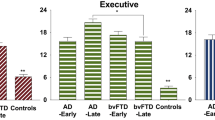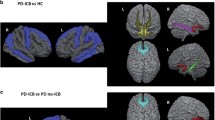Abstract
Neuroanatomical correlates of apathy and disinhibition, behavioral abnormalities in behavioral variant Frontotemporal dementia (bvFTD) remain unclear. In this study 45 participants (25 bvFTD patients and 20 controls) provided data on clinical, neuropsychological, behavioral (on Frontal Systems Behavior (FrSBe) Scale), cortical volume (on voxel-based morphometry (VBM)) and tract based spatial fractional anisotropy ((FA) on magnetic resonance imaging (MRI), allowing examination of the neural correlates of apathy and disinhibition. The patients with bvFTD had predominant grey matter loss and corresponding white matter fractional anisotropy reduction in the frontal and temporal lobe compared to the controls. Grey matter loss in frontal, temporal and limbic structures correlated with apathy and degeneration in temporal limbic brain areas correlated with disinhibition. FA changes in inferior fronto-occipital fasciculus and forceps minor correlated with apathy and fibre integrity changes in the superior longitudinal fasciculus correlated with disinhibition. The current study suggests that apathy and disinhibition arises due to changes in the frontal, temporal and limbic brain areas in bvFTD.




Similar content being viewed by others
References
Baeuchl, C., Meyer, P., Hoppstädter, M., Diener, C., & Flor, H. (2015). Contextual fear conditioning in humans using feature-identical contexts. Neurobiology of Learning and Memory, 121, 1–11. https://doi.org/10.1016/j.nlm.2015.03.001.
Bakchine, S. (2000). Temporal lobe behavioral syndromes. In J. Bogousslavsky & J. Cummings (Eds.), Behavior and Mood Disorders in Focal Brain Lesions (pp. 369–398). Cambridge: Cambridge University Press.
Borroni, B., Brambati, S. M., Agosti, C., Gipponi, S., Bellelli, G., Gasparotti, R., … Padovani, A. (2007). Evidence of white matter changes on diffusion tensor imaging in frontotemporal dementia. Archives of Neurology, 64(2), 246–251. https://doi.org/10.1001/archneur.64.2.246
Brown, R. G., & Pluck, G. (2000). Negative symptoms: The “pathology” of motivation and goal-directed behaviour. Trends in Neurosciences, 23(9), 412–417.
Cummings, J. L. (1995). Anatomic and behavioral aspects of frontal-subcortical circuits. Annals of the New York Academy of Sciences, 769, 1–13.
Eslinger, P. J., Moore, P., Antani, S., Anderson, C., & Grossman, M. (2012). Apathy in frontotemporal dementia: Behavioral and neuroimaging correlates. Behavioural Neurology, 25(2), 127–136. https://doi.org/10.3233/BEN-2011-0351.
Folstein, M. F., Folstein, S. E., & McHugh, P. R. (1975). Mini-mental state.° a practical method for grading the cognitive state of patients for the clinician. Journal of Psychiatric Research, 12(3), 189–198.
Franceschi, M., Anchisi, D., Pelati, O., Zuffi, M., Matarrese, M., Moresco, R. M., Fazio, F., & Perani, D. (2005). Glucose metabolism and serotonin receptors in the frontotemporal lobe degeneration. Annals of Neurology, 57(2), 216–225. https://doi.org/10.1002/ana.20365.
Grossman, M., Eslinger, P. J., Troiani, V., Anderson, C., Avants, B., Gee, J. C., … Antani, S. (2010). The Role of ventral medial prefrontal cortex in social decisions: converging evidence from fMRI and frontotemporal lobar degeneration. Neuropsychologia, 48(12), 3505–3512. https://doi.org/10.1016/j.neuropsychologia.2010.07.036
Hornberger, M., Geng, J., & Hodges, J. R. (2011). Convergent grey and white matter evidence of orbitofrontal cortex changes related to disinhibition in behavioural variant frontotemporal dementia. Brain: A Journal of Neurology, 134(Pt 9), 2502–2512. https://doi.org/10.1093/brain/awr173.
Hughes, C. P., Berg, L., Danziger, W. L., Coben, L. A., & Martin, R. L. (1982). A new clinical scale for the staging of dementia. The British Journal of Psychiatry, 140, 566–572.
Krueger, C. E., Laluz, V., Rosen, H. J., Neuhaus, J. M., Miller, B. L., & Kramer, J. H. (2011). Double dissociation in the anatomy of socioemotional disinhibition and executive functioning in dementia. Neuropsychology, 25(2), 249–259. https://doi.org/10.1037/a0021681.
Kumfor, F., Irish, M., Hodges, J. R., & Piguet, O. (2013). Discrete neural correlates for the recognition of negative emotions: Insights from frontotemporal dementia. PLoS One, 8(6), e67457. https://doi.org/10.1371/journal.pone.0067457.
Le Ber, I., Guedj, E., Gabelle, A., Verpillat, P., Volteau, M., Thomas-Anterion, C., et al. (2006). Demographic, neurological and behavioural characteristics and brain perfusion SPECT in frontal variant of frontotemporal dementia. Brain: A Journal of Neurology, 129(Pt 11), 3051–3065. https://doi.org/10.1093/brain/awl288.
Levita, L., Bois, C., Healey, A., Smyllie, E., Papakonstantinou, E., Hartley, T., & Lever, C. (2014). The Behavioural inhibition system, anxiety and hippocampal volume in a non-clinical population. Biology of Mood & Anxiety Disorders, 4(1), 4. https://doi.org/10.1186/2045-5380-4-4.
Levy, R., & Dubois, B. (2006). Apathy and the functional anatomy of the prefrontal cortex-basal ganglia circuits. Cerebral Cortex (New York, N.Y.: 1991), 16(7), 916–928. https://doi.org/10.1093/cercor/bhj043.
Malloy, P., Tremont, G., Grace, J., & Frakey, L. (2007). The frontal systems behavior scale discriminates frontotemporal dementia from Alzheimer’s disease. Alzheimer’s & Dementia: The Journal of the Alzheimer’s Association, 3(3), 200–203. https://doi.org/10.1016/j.jalz.2007.04.374.
Massimo, L., Powers, C., Moore, P., Vesely, L., Avants, B., Gee, J., Libon, D. J., Grossman, M. (2009). Neuroanatomy of apathy and disinhibition in frontotemporal lobar degeneration. Dementia and Geriatric Cognitive Disorders, 27 (1), 96–104.
Massimo, L., Powers, J. P., Evans, L. K., McMillan, C. T., Rascovsky, K., Eslinger, P., Ersek, M., Irwin, D. J., & Grossman, M. (2015). Apathy in frontotemporal degeneration: Neuroanatomical evidence of impaired goal-directed behavior. Frontiers in Human Neuroscience, 9, 611. https://doi.org/10.3389/fnhum.2015.00611.
Mathuranath, P. S., Hodges, J. R., Mathew, R., Cherian, P. J., George, A., & Bak, T. H. (2004). Adaptation of the ACE for a Malayalam speaking population in southern India. International Journal of Geriatric Psychiatry, 19, 1–7.
McKhann, G. M. (2001). Clinical and Pathological Diagnosis of Frontotemporal Dementia. Archives of Neurology, 58(11), 1803.
Neary, D., Snowden, J., & Mann, D. (2005). Frontotemporal dementia. The Lancet Neurology, 4(11), 771–780. https://doi.org/10.1016/S1474-4422(05)70223-4.
Peters, F., Perani, D., Herholz, K., Holthoff, V., Beuthien-Baumann, B., Sorbi, S., Pupi, A., Degueldre, C., Lemaire, C., Collette, F., & Salmon, E. (2006). Orbitofrontal dysfunction related to both apathy and disinhibition in frontotemporal dementia. Dementia and Geriatric Cognitive Disorders, 21(5–6), 373–379. https://doi.org/10.1159/000091898.
Powers, J. P., Massimo, L., McMillan, C. T., Yushkevich, P. A., Zhang, H., Gee, J. C., & Grossman, M. (2014). White matter disease contributes to apathy and disinhibition in behavioral variant frontotemporal dementia. Cognitive and Behavioral Neurology: Official Journal of the Society for Behavioral and Cognitive Neurology, 27(4), 206–214. https://doi.org/10.1097/WNN.0000000000000044.
Rascovsky, K., Hodges, J. R., Knopman, D., Mendez, M. F., Kramer, J. H., Neuhaus, J., van Swieten, J. C., Seelaar, H., Dopper, E. G. P., Onyike, C. U., Hillis, A. E., Josephs, K. A., Boeve, B. F., Kertesz, A., Seeley, W. W., Rankin, K. P., Johnson, J. K., Gorno-Tempini, M. L., Rosen, H., Prioleau-Latham, C. E., Lee, A., Kipps, C. M., Lillo, P., Piguet, O., Rohrer, J. D., Rossor, M. N., Warren, J. D., Fox, N. C., Galasko, D., Salmon, D. P., Black, S. E., Mesulam, M., Weintraub, S., Dickerson, B. C., Diehl-Schmid, J., Pasquier, F., Deramecourt, V., Lebert, F., Pijnenburg, Y., Chow, T. W., Manes, F., Grafman, J., Cappa, S. F., Freedman, M., Grossman, M., & Miller, B. L. (2011). Sensitivity of revised diagnostic criteria for the behavioural variant of frontotemporal dementia. Brain: A Journal of Neurology, 134(Pt 9), 2456–2477. https://doi.org/10.1093/brain/awr179.
Robert, P. H., Clairet, S., Benoit, M., Koutaich, J., Bertogliati, C., Tible, O., Caci, H., Borg, M., Brocker, P., & Bedoucha, P. (2002). The apathy inventory: Assessment of apathy and awareness in Alzheimer’s disease, Parkinson’s disease and mild cognitive impairment. International Journal of Geriatric Psychiatry, 17(12), 1099–1105. https://doi.org/10.1002/gps.755.
Rosen, H. J., Allison, S. C., Schauer, G. F., Gorno-Tempini, M. L., Weiner, M. W., & Miller, B. L. (2005). Neuroanatomical correlates of behavioural disorders in dementia. Brain: A Journal of Neurology, 128(Pt 11), 2612–2625. https://doi.org/10.1093/brain/awh628.
Sah, P., Faber, E. S. L., Lopez De Armentia, M., & Power, J. (2003). The amygdaloid complex: Anatomy and physiology. Physiological Reviews, 83(3), 803–834. https://doi.org/10.1152/physrev.00002.2003.
Smith, S. M., Jenkinson, M., Johansen-Berg, H., Rueckert, D., Nichols, T. E., Mackay, C. E., Watkins, K. E., Ciccarelli, O., Cader, M. Z., Matthews, P. M., & Behrens, T. E. J. (2006). Tract-based spatial statistics: Voxelwise analysis of multi-subject diffusion data. NeuroImage, 31(4), 1487–1505. https://doi.org/10.1016/j.neuroimage.2006.02.024.
Snowden, J. S., Bathgate, D., Varma, A., Blackshaw, A., Gibbons, Z. C., Neary, D. (2001). Distinct behavioural profiles in frontotemporal dementia and semantic dementia. J Neurol Neurosurg Psychiatry, 70(3), 323–32.
Walters, G. D., & Kiehl, K. A. (2015). Limbic correlates of fearlessness and disinhibition in incarcerated youth: Exploring the brain-behavior relationship with the psychopathy checklist: Youth version. Psychiatry Research, 230(2), 205–210. https://doi.org/10.1016/j.psychres.2015.08.041.
Whitwell, J. L., Sampson, E. L., Loy, C. T., Warren, J. E., Rossor, M. N., Fox, N. C., & Warren, J. D. (2007). VBM signatures of abnormal eating behaviours in frontotemporal lobar degeneration. NeuroImage, 35(1), 207–213. https://doi.org/10.1016/j.neuroimage.2006.12.006.
Williams, G. B., Nestor, P. J., Hodges, J. R. (2005). Neural correlates of semantic and behavioural deficits in frontotemporal dementia. NeuroImage, 24(4), 1042–1051.
Zamboni, G., Huey, E. D., Krueger, F., Nichelli, P. F., & Grafman, J. (2008). Apathy and disinhibition in frontotemporal dementia: Insights into their neural correlates. Neurology, 71(10), 736–742. https://doi.org/10.1212/01.wnl.0000324920.96835.95.
Acknowledgements
The authors wish to thank the participants in this study and their caregivers.
Author Contribution: SR, BC and TV carried out the study and did data collection and data analysis. SR, KC, JV and PSM contributed to the preparation of the manuscript. PSM conceived the idea of and designed the study and got the grant for carrying out the study. JV contributed to getting the grant for the study.
Funding
This study was supported by grants provided by the National Institute on Aging (NIA), USA (grant no. R21AG029799 to JV and R01AG039330–01) to PSM.
Author information
Authors and Affiliations
Corresponding author
Ethics declarations
Conflict of interest
The authors declare no conflict of interest.
Ethics approval
All procedures performed in studies involving human participants were in accordance with the ethical standards of the institutional and/or national research committee and with the 1964 Helsinki declaration and its later amendments or comparable ethical standards. This article does not contain any studies with animals performed by any of the authors.
Informed consent
Informed consent was obtained from all individual participants included in the study.
Additional information
Publisher’s note
Springer Nature remains neutral with regard to jurisdictional claims in published maps and institutional affiliations.
Electronic supplementary material
ESM 1
(DOCX 23 kb)
Supplementary Fig. 1
Regions of reduced gray matter density (red-yellow) in behavioral variant FTD subjects compared to controls, P < 0.05(FWE corrected). (PNG 316 kb)
Supplementary Fig. 2
Patterns of white matter tract degeneration in behavioral variant group compared with controls. Tract based spatial statistics voxel wise group differences (significance level of P < 0.05, FWE corrected for multiple comparisons across space using threshold free cluster enhancement) are shown in red-yellow (FA). (PNG 362 kb)
Rights and permissions
About this article
Cite this article
Sheelakumari, R., Bineesh, C., Varghese, T. et al. Neuroanatomical correlates of apathy and disinhibition in behavioural variant frontotemporal dementia. Brain Imaging and Behavior 14, 2004–2011 (2020). https://doi.org/10.1007/s11682-019-00150-3
Published:
Issue Date:
DOI: https://doi.org/10.1007/s11682-019-00150-3




